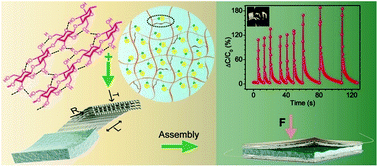Muscle-inspired capacitive tactile sensors with superior sensitivity in an ultra-wide stress range†
Abstract
Taking inspiration from skeletal muscle with highly oriented myofibers, we developed a tough wood aerogel/poly(ionic liquid) (WA/PIL) hydrogel directly from wood via delignification, impregnation and gelation for the formation of a tactile sensor of electric double-layer capacitive configuration. The WA/PIL hydrogels integrated the representative properties of both wood and ionic liquids, being a promising candidate for both polyelectrolyte and separator materials. The influences of the wood texture and cross-linker (Bis) content on the mechanical and sensing performances of the hydrogels were investigated. The results showed that the tangential hydrogel slice with a 1.0 mol% Bis content (tan 1.0) displayed the most significant improvement in compressive stress (1.65 MPa) and deformation (73.3%) at fracture, suggesting the best compressibility. Electrodes also played a significant role in the sensitivity and stability of the sensor devices. While tan 1.0 with reduced graphene oxide (rGO) electrodes displayed the largest sensitivities (1.13–19.70 MPa−1), tan 1.0 with Ni foams possessed much more stable ionic signals within the whole stress range with sensitivities of 0.33–9.67 MPa−1. Due to the wide-stress-range responsiveness of our hydrogel sensor from gentle finger contact to vigorous hitting modes, it will find promising applications in various human–machine interfaces in the fields of electronics, recreation, sports, etc.



 Please wait while we load your content...
Please wait while we load your content...